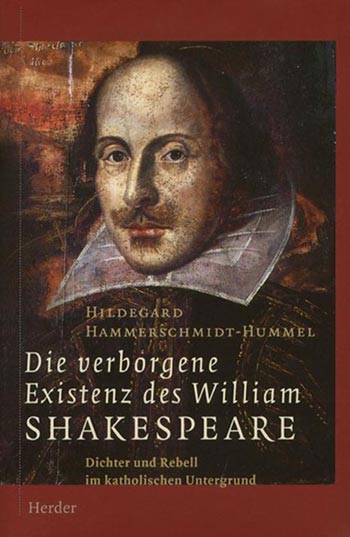Book review by the Swiss journalist Hans-Viktor von Sury, ”Shakespeare’s
secret double life. Let pictures speak – and experts. The interlinked
thinking of the Shakespeare scholar Hildegard Hammerschmidt-Hummel reveals
Shakespeare’s religion and provides the key to his work”,
Schweiz. Kath. Wochenzeitung (12 April 2002) (On Die verborgene
Existenz des William Shakespeare /William Shakespeare’s hidden existence)
- Excerpt:
”3. Security thanks to plausibility and interlinked thinking"
HHH relies on an unbelievably finely woven and dense net of innumerable facts, documents, hypotheses and combinations. How these are put together to form a blurred but not contradictory picture is no less exciting than Shakespeare’s double life. Just like a trial based on circumstantial evidence the details as such tell us little. Only if combined and put in context are they plausible and conclusive.
What HHH demonstrates is interlinked thinking par excellence. This kind of drawing conclusions that leads to more or less probable or plausible results is typical of HHH – and absolutely realistic.
In information technology the phenomenon is well-known
in connection with the so-called neuronal networks: A great number of
uncertain, at best probable connections may, if linked up, lead to a conclusive
and safe result. Networks do have the capability to function even if individual
meshes tear up or are damaged. It is in the logic of the matter that HHH
is so sure of herself.
Together with her keen powers of observation, typical of her, and her
phenomenological knowledge about Shakespeare’s historical environment
and Elizabethan-Jacobean contemporary history an impressive general picture
is created which leaves critics no great chance. It is a fact that hitherto
not much of useful criticism and counterarguments has surfaced. For proof
of the contrary, that is the falsification of the conclusions HHH has
come to, each step, each mesh of the network would have to be refuted
– or, at least, it would have to be shown that the author has overlooked
important and decisive details which contradict her claims essentially.
Therefore, somewhat resignedly but factually correct [her critics] stated
that as long as HHH’s theses were not falsified one would have to
accept them.
If HHH is – with regard to her results – that sure of herself, then these are factual reasons. If there is someone who wants to correct her results, or, above all, to continue and enlarge them, it would be the author herself.”
***










